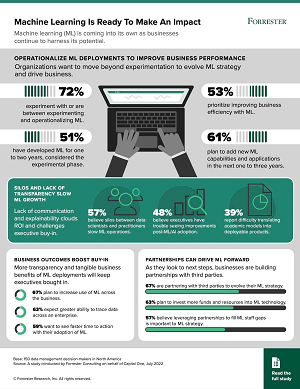News
Automated Anomaly Detection Is Top Priority for ML Operationalization
New research indicates the next few years will be crucial for organizations seeking to operationalize machine learning technology, with automated anomaly detection predicted to figure prominently in that effort.
That's a key takeaway from the new "Operationalizing Machine Learning Achieves Key Business Outcomes" report, based on a survey conducted by Forrester Consulting on behalf of financial firm Capital One, which sought to investigate organizational machine learning goals, challenges and plans to operationalize ML.
According to an Oct. 23 post from Capital One, "ML is beginning to drive business impact, with automated anomaly detection as the top priority in the next one year to three years."
In those next few years, the firm said, organizations need to move past experimentation with ML to fully realize automation and deployment of applications with tangible results that can drive widespread business success.
 [Click on image for larger view.] Machine Learning Is Ready to Make an Impact (source: Capital One/Forrester Consulting).
[Click on image for larger view.] Machine Learning Is Ready to Make an Impact (source: Capital One/Forrester Consulting).
During that crucial time period, the report said, ML will be used to address top priorities, with anomaly detection being front and center as it supplants today's immediate No. 1 priority, multicloud.
"As organizations continue to experiment with ML, decision-makers are focusing on increasing efficiencies across their organizations," the report said. "At the same time, they are laying the foundation for ML success with IT-heavy data and analytics strategies, focusing on multicloud, building a better performance stack, and scaling to changing data demands.
 [Click on image for larger view.] Data/Analytics Strategies (source: Capital One/Forrester Consulting).
[Click on image for larger view.] Data/Analytics Strategies (source: Capital One/Forrester Consulting).
"As ML evolves, data and analytics strategies will shift alongside it, with deployment of ML to automate anomaly detection replacing multicloud as decision-makers' top priority in the next one year to three years. Once they lay the foundation and move toward maturity, decision-makers will likely shift their focus to growing revenue and improving CX with their ML applications."
Other key takeaways from the report as presented by Capital One include:
-
Despite their goals to operationalize ML, organizations face difficulties with data silos, explainability and transparency, slowing maturity. 57 percent of respondents believe silos between data scientists and practitioners present ML deployment challenges. "In addition to the technical competencies required to operationalize ML, organizations are experiencing roadblocks around people and processes," the report said. "When asked about the ML challenges their organizations faced, decision-makers noted that internal, cross-organizational and external data silos slowed ML deployments and outcomes.
 [Click on image for larger view.] Biggest Challenges (source: Capital One/Forrester Consulting).
[Click on image for larger view.] Biggest Challenges (source: Capital One/Forrester Consulting).
"In addition, difficulties in translating academic models into deployable products are hindering operationalization. Alongside internal and external data silos, the lack of connection between academic or scientific models and tangible insights needed for business success is slowing the momentum needed to drive ML strategies forward."
-
To overcome challenges, organizations must focus on the business outcomes of ML and build partnerships with proven leaders in their ML journey. 67 percent of respondents intend to leverage partnerships to fill gaps in ML staff, the report said. "To address the challenges of current ML strategies and enhance model development, training, and data sourcing, two-thirds of respondents' organizations are currently partnering with a third party. Close to one-fifth of respondents' organizations plan to begin a partnership in the next year.
 [Click on image for larger view.] Partnering Plans (source: Capital One/Forrester Consulting).
[Click on image for larger view.] Partnering Plans (source: Capital One/Forrester Consulting).
"To push their organizations out of the experimentation phase, decision-makers should seek out ML partners that have firsthand experience in building and operationalizing ML applications. These partnerships will help organizations resolve their explainability, transparency, and skills gap issues and create an AI/ML ecosystem and community of practice, setting organizations up for success in scaling their ML strategies."
In a conclusion summarizing the entire report, Capital One said: "Data management decision-makers believe in the promise of AI/ML to grow their businesses. To keep executives bought in, they are moving their organizations out of experimentation and toward operationalizing their ML strategies. To continue to evolve their ML applications, decision-makers must overcome silos among both people and processes. They must also find better ways to translate academic models into deployable products to better illustrate ROI to executives.
"By leveraging partners with firsthand experience and remaining relentlessly focused on the business promise of ML, decision-makers can prove the key outcomes of operationalizing ML like efficiency, productivity, and improved CX to executive leadership. With leadership buy-in, organizations can then pivot to scaling and operationalizing ML applications."
The report is based on a survey of 150 data management decision-makers in North America completed in July.
About the Author
David Ramel is an editor and writer at Converge 360.